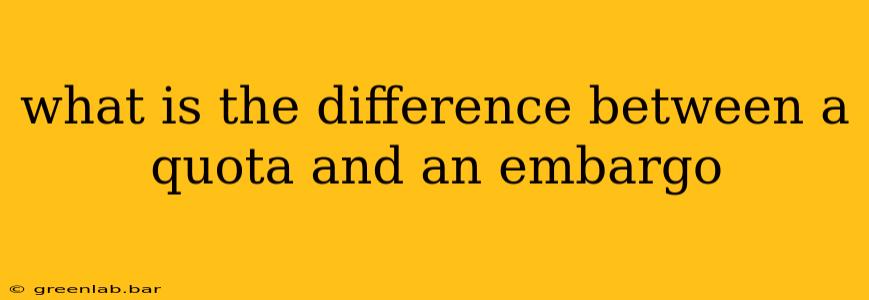Quota vs. Embargo: Understanding the Key Differences in Trade Restrictions
Both quotas and embargoes are trade restrictions used by governments to control the flow of goods and services across international borders. However, they differ significantly in their scope and objectives. Understanding these differences is crucial for businesses involved in international trade and for anyone seeking to grasp global economic policy.
What is a Quota?
A quota is a limit on the quantity of a specific good or service that can be imported or exported within a given period. It's a quantitative restriction, setting a numerical cap on trade volume. Governments implement quotas to protect domestic industries from foreign competition, manage resource scarcity, or respond to balance-of-payments concerns.
Key Characteristics of Quotas:
- Quantitative Limit: The core feature is a numerical restriction on the amount traded.
- Specific Goods/Services: Quotas typically target particular products, not entire sectors.
- Time-Bound: Quotas are usually implemented for a defined period, after which they may be renewed, modified, or removed.
- Potential for Licensing: Governments often allocate quotas through a licensing system, distributing permits to importers or exporters.
- Price Impact: Quotas can lead to higher domestic prices for the restricted goods as supply is artificially constrained.
What is an Embargo?
An embargo is a complete ban on trade with a particular country or in specific goods with one or more countries. It's a much more severe restriction than a quota, representing a complete prohibition of trade rather than a limitation. Embargoes are typically used as a political or economic sanction, often in response to geopolitical events or human rights violations.
Key Characteristics of Embargoes:
- Complete Prohibition: Embargoes completely halt trade in the specified goods or with the targeted country.
- Broader Scope: While quotas may target specific products, embargoes often encompass a wider range of goods or services, or even all trade.
- Political Tool: Embargoes are primarily employed as political instruments to exert pressure on other nations.
- Severe Economic Impact: Embargoes can have significant economic consequences for both the targeted country and the country imposing the embargo.
- International Implications: Embargoes often involve complex international legal and diplomatic considerations.
Quota vs. Embargo: A Table Summarizing the Differences
| Feature | Quota | Embargo |
|---|---|---|
| Nature | Quantitative restriction (limit) | Complete prohibition |
| Scope | Specific goods or services | Specific goods, services, or entire countries |
| Objective | Protect domestic industry, manage supply | Political pressure, economic sanction |
| Severity | Less severe | More severe |
| Enforcement | Licensing systems, customs controls | Strict border controls, legal penalties |
| Impact | Higher domestic prices, limited supply | Significant economic disruption |
Conclusion:
While both quotas and embargoes restrict international trade, they operate on different scales and serve distinct purposes. Quotas are more targeted and quantitatively focused, primarily aiming to manage trade flows. Embargoes, on the other hand, are broader, more severe, and primarily used as powerful political and economic tools. Understanding these nuances is vital for navigating the complexities of global commerce and international relations.

